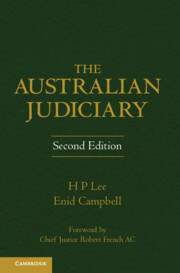Book contents
- Frontmatter
- Contents
- Preface
- Acknowledgments
- Table of Cases
- Table of Statutes
- Chapter 1 Introduction
- Chapter 2 The courts and judges
- Chapter 3 The judiciary as a branch of government
- Chapter 4 Appointment and conditions of service
- Chapter 5 Removal, suspension and discipline of judges
- Chapter 6 Judicial conduct
- Chapter 7 Extra-judicial activities of judges
- Chapter 8 Protecting judicial institutions
- Chapter 9 The accountability of judges
- Chapter 10 A public trust
- Appendix 1 Judicial statistics tables
- Guide to Judicial Conduct
- Index
- References
Chapter 3 - The judiciary as a branch of government
Published online by Cambridge University Press: 05 December 2012
- Frontmatter
- Contents
- Preface
- Acknowledgments
- Table of Cases
- Table of Statutes
- Chapter 1 Introduction
- Chapter 2 The courts and judges
- Chapter 3 The judiciary as a branch of government
- Chapter 4 Appointment and conditions of service
- Chapter 5 Removal, suspension and discipline of judges
- Chapter 6 Judicial conduct
- Chapter 7 Extra-judicial activities of judges
- Chapter 8 Protecting judicial institutions
- Chapter 9 The accountability of judges
- Chapter 10 A public trust
- Appendix 1 Judicial statistics tables
- Guide to Judicial Conduct
- Index
- References
Summary
Introduction
At Commonwealth, State and Territory levels in Australia, the judiciary is a branch of government separate from the legislative and executive branches and independent of them. The functions of the courts also differ from those of the other branches of government. While courts have a capacity to shape the law, it is a limited capacity. The principal function of courts is, of course, to adjudicate disputes according to the law. Judges cannot develop the law except in the course of an adjudication, and then only in an incremental fashion.
The judicial branches of government are separate from the other branches in the sense that their members cannot be members of the legislature, and, subject to a few exceptions, judges cannot act as agents of the executive branch. The judicial branches can be regarded as independent of the other branches so long as their members are assured that they are able to exercise the judicial function free from interference by either a legislature or an executive, and also that they cannot be prejudiced by other branches simply on account of their decisions.
- Type
- Chapter
- Information
- The Australian Judiciary , pp. 49 - 83Publisher: Cambridge University PressPrint publication year: 2012

